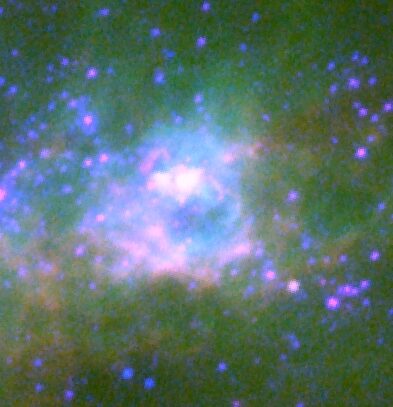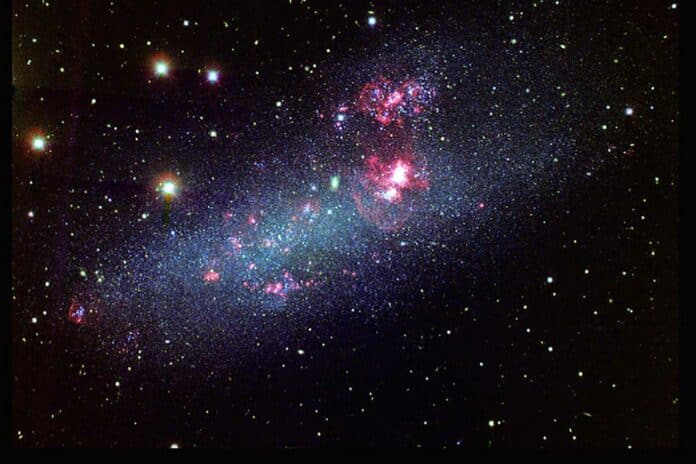Dwarf galaxies that are less developed have larger regions of star factories and higher star formation rates. Researchers from the University of Michigan have found the cause: these galaxies have a 10-million-year grace period before spewing out the gas that clogs their surroundings. More stars can form and develop because star-forming regions can hold onto gas and dust.
Stars in the dwarf galaxies collapse into black holes instead of exploding as supernovae. However, in more evolved, polluted galaxies, they tend to explode, hence generating a collective superwind. The galaxy is blasted with gas and dust, and star creation abruptly ends.
Michelle Jecmen, the study’s first author and an undergraduate researcher, said, “As stars go supernova, they pollute their environment by producing and releasing metals. We argue that at low metallicity—relatively unpolluted galaxy environments—there is a 10-million-year delay in the start of strong superwinds, resulting in higher star formation.”
The researchers point to a figure known as the “Hubble tuning fork,” which shows how astronomer Edwin Hubble categorized galaxies. The largest galaxies are in the tuning fork’s handle. These galaxies are massive, spherical, and teeming with stars; they have already converted all their gas into stars. Spiral galaxies with gas and star-forming regions along their compact arms are found along the tuning fork’s tines. The smallest and least evolved galaxies are located at the end of the tuning fork’s tines.
U-M astronomer Sally Oey, senior author of the study, said, “But these dwarf galaxies have just these really mondo star-forming regions. There have been some ideas around why that is, but Michelle’s finding offers a very nice explanation: These galaxies have trouble stopping their star formation because they don’t blow away their gas.”
Michelle Jecmen, study first author and an undergraduate researcher, said, “Additionally, this 10-million-year period of quiet offers astronomers the opportunity to peer at scenarios similar to the cosmic dawn, a period just after the Big Bang. In pristine dwarf galaxies, gas clumps together and forms gaps through which radiation can escape. This previously known phenomenon is called the “picket fence” model, with UV radiation escaping between slats. The delay explains why gas would have had time to clump together.”

Ultraviolet radiation is significant because it ionizes hydrogen, which also happened immediately after the Big Bang and caused the universe to change from opaque to transparent.
Thus, observing low-metallicity dwarf galaxies that emit a lot of UV light is comparable to gazing back in time to the cosmic dawn. It’s fascinating to learn about the period right before the Big Bang. It forms the basis of our understanding. Amazingly, we can observe comparable circumstances in galaxies that still exist, even though it happened long ago.
In a second study, researchers used the Hubble Space Telescope to examine Mrk 71, a region in a dwarf galaxy around 10 million light years away. The researchers discovered observational evidence supporting Jecmen’s hypothesis in Mrk 71. The scientists used a filter set that examines the light of triply ionized carbon, a novel technique with the Hubble Space Telescope.
Oey said, “In more evolved galaxies with many supernova explosions, those explosions heat gas in a star cluster to very high temperatures—to millions of degrees Kelvin. As this hot superwind expands, it blasts the rest of the gas out of the star clusters. But in low metallicity environments such as Mrk 71, where stars aren’t blowing up, the energy within the region is radiated away. It doesn’t have the chance to form a superwind.”
The team’s filters detected the diffuse glow of the ionized carbon throughout Mrk 71, indicating that the energy is radiating outward. As a result, the environment is still filled with thick gas, and there is no hot superwind.
Scientists noted, “Our findings may also be important in explaining the properties of galaxies that are being seen at cosmic dawn by the James Webb Space Telescope right now. I think we’re still in the process of understanding the consequences.”
Journal Reference:
- Michelle C. Jecmen and M. S. Oey. Delayed Massive-star Mechanical Feedback at Low Metallicity. The Astrophysical Journal. DOI: 10.3847/1538-4357/ad0460
